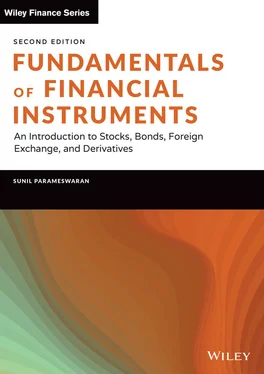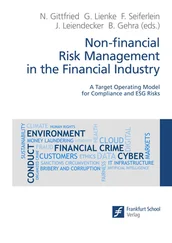Mispriced ADRs will be exploited by arbitrageurs. We will illustrate this with the help of an example.
Let's assume that shares of the Indian information technology company Infosys Technologies are quoting at INR 1,500 on the National Stock Exchange (NSE) in Mumbai, and that Infosys ADRs, where each ADR represents 20 domestic shares, are quoting at $410 on the NYSE. The current exchange rate is INR 75 per USD.
Quite obviously the ADRs are overvalued, for the dollar equivalent of 20 shares should be $400. An arbitrageur will short sell the ADRs in New York, acquiring 20 shares on the NSE for every ADR that is sold short, and then deliver them to the custodian bank in Mumbai, which will inform the depository bank in New York. On receiving intimation from Mumbai, the bank in New York will issue an ADR which can be used to cover the short position. The cost of acquisition of 20 shares in Mumbai will be INR 30,000 or $400. The proceeds from the short sale in New York will be $410. Consequently, an arbitrage profit of $10 can be earned.
Now let's examine a situation where ADRs are undervalued. What if the price of the Infosys ADR were to be $390? If so, an arbitrageur would acquire an ADR for $390 and deliver it to the depository bank in New York with instructions to sell the underlying shares in Mumbai. The sale proceeds will amount to INR 30,000 or $400. Once again, the arbitrageur will realize an arbitrage profit of $10.
J.P. Morgan was a pioneer in the creation of ADRs. They created the first ADR in 1927 to facilitate investment in foreign companies by American investors. An ADR is considered to be an American security, and consequently is freely tradable in the United States. It is akin to any other domestic security for the purpose of clearing and settlement.
While ADRs are the most common type of depository receipts, there are other similar securities called GDRs. A global depository receipt (GDR) differs from an ADR in the sense that it is offered to investors in two or more markets outside the issuer's home country. Most such issues will include a tranche for US investors, as well as a separate tranche for international investors.
EDRs or Euro Depository Receipts represent ownership of shares in a corporation that is based in a country outside the European Monetary Union (EMU). While depository receipts are primarily issued to facilitate ownership of overseas equity, they can also be structured to permit investors to take a stake in a foreign debt issue. An American Depository Debenture (ADD) is a security that is based on a debt security issued by a foreign company.
Risk is defined as a position whose outcome is uncertain, and which has the potential to give rise to a loss for the holder. Assume that you are offered a security that will give a 20% return with a probability of 50% and a 40% return with the same probability. This is not a risky position, for, although the outcome is uncertain, there is no possibility of a loss. Similarly, take the case of an investment that is guaranteed to give a return of –10%. This too is not a risky position, for while there is a loss for the investor, there is no uncertainty regarding the outcome. So, what is an example of a risky position? Take the case of an investment in a share that will give a return of 0% with 25% probability, –10% with 25% probability, and 10% with 50% probability. This is clearly risky, for the outcome can take one of three possible values, one of which would lead to a loss for the investor. Financial securities are exposed to multiple types of risks.
Credit Risk: This is the risk that the deficit budget unit, which raises funds, may not make payments as promised to the investor. For instance, a business may issue bonds to the public with a face value of $1,000, and an assured interest rate of 10% to be paid every year. At the end of a financial year, however, it may be unable to make the promised interest payment. Or else, at the time of maturity of the security, it may be unable to repay the principal in full. Similarly, a financial institution like a bank, which makes loans to borrowers, is also faced with the specter of nonpayment. Such risk is also termed as default risk.
Price Risk: Price risk or market risk is the risk that the price of the security at the time of purchase may be higher than its price at the point of a subsequent sale. In other words, it is the risk that there could be a capital loss for the investor. All marketable securities are subject to such risk.
Reinvestment Risk: Whenever investors receive a cash flow from a security, they should reinvest it in the market, in order to ensure that they get an anticipated compounded rate of return. There is always a risk, however, that the prevailing market interest rate may be lower than what was expected at the outset. If so, the investor will have to settle for a lower than anticipated compounded rate of return. Such risk is termed as reinvestment risk.
Inflation Risk: Inflation, or the erosion of purchasing power of money, is associated with every investment. Every investor will have a required rate of return that will include a premium for the anticipated rate of inflation; however, if the rate of inflation were to be higher than anticipated, the effective rate of return in terms of the ability to buy goods and services may be lower than expected. The return from a security in the absence of inflation is termed as the real rate. All investors will obviously demand a positive real rate of return. They will add a mark-up to this for the expected inflation, to arrive at what is called the nominal or money rate of interest. If inflation is higher than anticipated, however, the real rate received at maturity may be less than expected and can possibly be negative. The anticipated interest rate is referred to as the ex-ante rate. The interest rate that is eventually received is termed as the ex-post rate. In the absence of default, the ex-ante nominal rate will be equal to the ex-post nominal rate. However, because of inflation, the ex-post real rate may be lower or higher than anticipated and may possibly be negative.For instance, assume that the ex-ante real rate is 4% per annum and the expected inflation is 2.5% per annum. Thus, the nominal rate will be set at . However, if the actual rate of inflation is 4% per annum, the ex-post real rate will be only 2.5% per annum. If the actual rate of inflation were to be 8% per annum, the ex-post real rate will be a negative 1.30% per annum.
Liquidity Risk: We have already expounded on this issue. Whenever funds are blocked in an investment, there is always the risk that at the time of its subsequent sale, the market may not be as liquid as it was at the time the securities were acquired. If so, the seller may have to make a substantial concession by way of a reduction in price in order to complete the transaction. It must be remembered that if a transaction takes a considerable amount of time for execution, there is an associated cost, for time is money. Thus, the absence of an adequate number of buyers or sellers poses a risk for a party seeking to sell or to buy.
Foreign Exchange Risk: This is a risk that is associated with an investment in a foreign country. If the domestic currency were to appreciate with respect to the currency in which the assets are denominated, there could be a loss for the investor.Assume that a US investor makes an investment of $100 in an Indian security when the exchange rate is INR 75 per dollar. At the end of one year, the price of the asset has increased from INR 7,500 to INR 7,800. Thus, there is a 4% return in rupee terms. However, the exchange rate at the end of the year is INR 80 per dollar. That is, the rupee has depreciated or the dollar has appreciated. Now, if the funds are repatriated to the United States, the American investor will receive only $97.50. Thus, there is a loss of 2.50% for him in dollar terms.
Читать дальше












